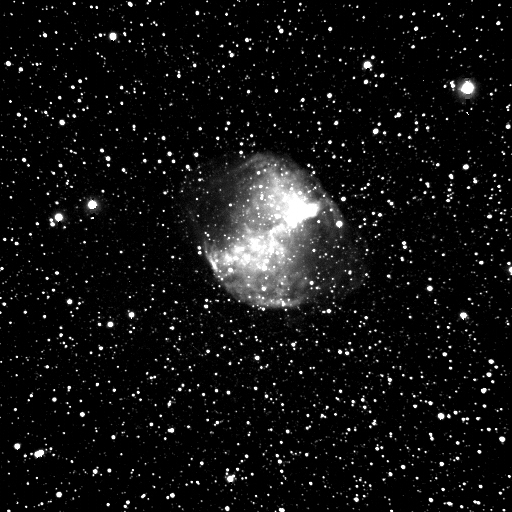
Photo and Article by Roy Clingan
M27 – Dumbbell Nebula

Photo and Article by Roy Clingan
Discovered by Charles Messier in 1764, this was the first planetary nebula to be cataloged. The name planetary nebula is a misnomer. After William Herschel discovered the planet Uranus in 1781, he noted that the newly discovered Messier object had a similar uniform disk to Uranus - though extended in size – and, so, designated the object a planetary nebula in 1784. This is as far as the connection to a planet goes. The word nebula is Greek for “cloud” and was used up until mid last century for anything fuzzy in appearance including galaxies.
This image is a look into our suns future. As stars age and burn up their fuel, they go through stages of evolution. As the fuel is consumed, the star will grow in size until it hits a critical point and then will blow off the outer envelope of gas and particles. This explosion can sometimes be so violent that it will actually distort time and space. It is estimated that our sun will go through this stage in another 4 – 5 billion years.
( I have one of the most loving wife’s imaginable. She has allowed me to build an observatory, buy a telescope, fit it with a very special electronic camera, etc., but the discussion of a new color camera has not yet come up. So, all of the images I take are unfortunately black and white. If you happen to see my wife in Wal-Mart sometime, please express to her your desire for color images.)
In “color” images of the
Dumbbell Nebula, the hydrogen and oxygen gas that was puffed off from
the dieing star produces red, green and blue hues. The central star
emits ultraviolet radiation, which causes the gas to glow similar to
a neon fixture. As fluorescent lights are 10 times more efficient in
producing light than regular tungsten (household lights), one can
make a comparison as to why a dim star can excite the gas and make
such a bright glow. M27 is estimated to be at a distance of 1200
light years away and is still one of the brightest nebulas in the
sky. When viewed through an amateur telescope, the nebula produces a
rare 3-D illusion. Today, many mysteries remain about the mechanics
of this bipolar planetary nebula.
Astronomy Note:
Astronomy 1014 will be offered in
Nashville at CCCUA this fall under Dr. David Rauls. The course will
cover introductory astronomy. Limited enrollment, so register early.
Red River Astronomy